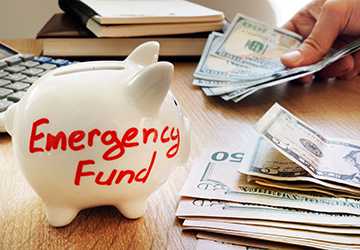How to Build an Emergency Fund: Steps for Financial Security
In an unpredictable world, achieving stability often starts with personal finance. Putting money aside for unexpected expenses is a wise move. This cushion of savings can be a lifesaver in times of need. This detailed article will explore the various financial security steps involved in creating a substantial and compelling emergency fund. Consider this your ultimate emergency savings guide.
Why You Need a Savings Account
Before we dive into how to build one, it's crucial to understand why an emergency fund is a non-negotiable element of any solid financial plan. Life's emergencies are unpredictable, from sudden medical expenses to unexpected home repairs or even job loss. An emergency fund can mean a minor financial hiccup and a major, life-altering financial setback. It is a vital financial security step that everyone should consider.

Initial Assessment: Know Your Expenses
The first stage in building an emergency fund is understanding your monthly expenses. Take stock of all your costs—from utility bills and groceries to insurance premiums and loan payments. Once you have a firm grasp of the situation, you should work to put away three to six months' worth of this money. This fund size is a good starting point for your emergency savings guide.
Setting Realistic Goals: A Step-by-Step Approach
Now that you know how much you'll need, it's time to set achievable goals. Instead of being daunted by the total sum, break it down into smaller, manageable milestones. For instance, if you need $12,000 in your emergency fund, start with a goal of saving $1,000. Achieving these smaller goals can motivate you, making them essential financial security steps.
Selecting the Right Savings Vehicle
Your emergency fund should be kept where you can get to it quickly. The best places to put your money are in a high-yield savings account, a money market account, or a short-term CD. Where you keep this money is another critical point in your emergency savings guide.
Budgeting for Your Emergency Fund
Budgeting is the backbone of building an emergency fund. Set aside a fixed monthly money to use as your emergency fund. Consistency is essential, even if your initial contribution is modest. Another important step towards financial security is setting up automatic transfers from your checking account to your emergency savings.
Finding Additional Income Streams
If your income doesn't allow you to save enough, consider creating additional income streams. Part-time jobs, freelance gigs, or even selling unused items can provide extra cash to funnel into your emergency fund. The speed at which you can build your fund is often directly related to these additional financial security steps.
Monitoring and Adjustments
It's more than just setting and remembering your emergency fund. Regular monitoring is crucial. Your emergency fund must be revised if your spending habits or income fluctuates. Constantly update your emergency savings guide to reflect these changes.
Combating Inflation
Remember that money's value erodes over time due to inflation. Periodically, revisit your emergency fund goals and adjust the total amount to counteract the effects of inflation. This is an often-overlooked yet crucial financial security step.
Resist Temptations
Once your savings grow, you may dip into the fund for non-emergencies. Please stick to the fund's purpose and resist using it for planned expenses like vacations or home renovations. Discipline is critical in successfully building an emergency fund.

Test Runs: Simulating Emergencies
Once you've reached your initial savings goal, consider doing a 'test run' by simulating an emergency. This exercise can help you evaluate how effectively your emergency fund can cover unexpected expenses, making it an advanced part of your emergency savings guide.
Emergency Fund for Entrepreneurs
Having an emergency fund is even more critical if you are self-employed or run a business. Income fluctuation can be more volatile, and an emergency fund provides a safety net during lean periods. For entrepreneurs, this is a mandatory financial security step.
In the landscape of personal finance, the significance of building an emergency fund cannot be overstated. Having the financial independence to act on life's opportunities rather than being forced to react to unforeseen circumstances is the actual value of an emergency fund. This in-depth article will serve as a multifaceted emergency savings guide, illustrating various financial security steps crucial for crafting a well-rounded emergency fund.
Why Does Everyone Need an Emergency Fund?
Before unpacking the how-to elements, let's first delve into the critical question: Why is building an emergency fund vital? An emergency fund acts as your financial buffer, shielding you from unforeseen outlays like medical bills, vehicle repairs, or sudden unemployment. This fund saves you from financial strain and prevents you from falling into debt. Thus, it's a fundamental financial security step that each individual should prioritize.
Calculating Your Needs: A Deep Dive into Your Expenses
The cornerstone of building an emergency fund is recognizing the amount you need to save. Conduct a meticulous analysis of your monthly expenses to arrive at this number. This involves thoroughly examining everything from day-to-day expenditures like food and transportation to recurring costs like mortgages and utilities. This comprehensive understanding sets the groundwork for your emergency savings guide.
A Phased Approach: Crafting Milestones
When building an emergency fund, the size of the amount can be intimidating. Rather than focusing on the significant end goal, try breaking it into smaller, attainable milestones. For instance, if you aim to have $18,000 in emergency savings, aim for $3,000. Achieving these mini-goals motivates and simplifies the task, making this approach a practical financial security step.
Conclusion
Putting together a rainy-day fund is more than a financial chore; it's a promise to your future self. The journey might seem challenging, but following these financial security steps can create a robust and reliable fund that stands up to life's uncertainties. Keep this emergency savings guide handy as a reference to help you through each stage of your emergency fund development.